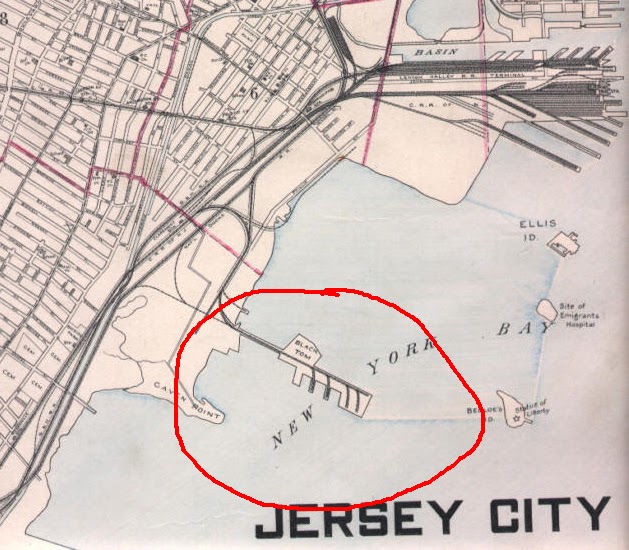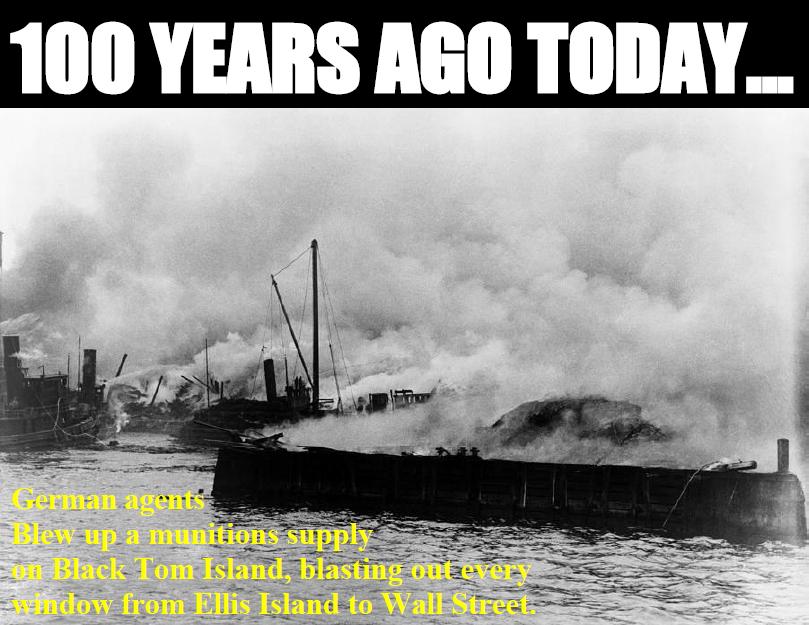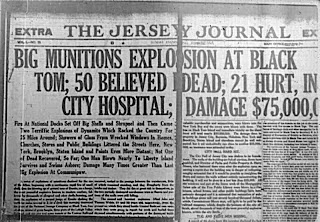|
Re: New Book - Tale of terrorism in Jersey City back in World War I. The Detonators by Chad Millman
|
||||
|---|---|---|---|---|
|
Home away from home
 
|
     
Posted on: 2017/4/25 19:46
|
|||
|
||||
|
Re: New Book - Tale of terrorism in Jersey City back in World War I. The Detonators by Chad Millman
|
||||
|---|---|---|---|---|
|
Home away from home
 
|
1916 'Black Tom' explosions shook Jersey City to its coreBy People were hurtled through the air, some lucky enough to dodge projectile debris. Others were awoken from a sound sleep to find the windows of their homes were shattered. The "Black Tom" explosions on the Jersey City waterfront were felt at least 25 miles away, The Jersey Journal reported in a special edition hours after the blasts. When the dust settled on July 30, 1916, fewer than a dozen people were killed and an estimated $75 million - the equivalent of $1.75 billion today - in damage had been done. A series of fires set off munitions on the island, named for a dark-skinned fisherman who had lived there many years, at 2:10 in the morning. The munitions - which have been estimated at 2 million pounds - were stored there for the Allies, who were fighting Germany in World War I. Only decades later were the explosions believed to be an act of sabotage by the Germans, who took advantage of what could only be considered extremely lax security. http://www.nj.com/jerseyjournal150/20 ... k_jersey_city_to_its.html
Posted on: 2017/4/24 16:38
|
|||
|
||||
|
90 Years Ago, New York harbor blew up
|
||||
|---|---|---|---|---|
|
Home away from home
 Joined:
2005/3/21 20:01 Last Login : 2020/9/5 14:18 From Exchange Place
Group:
Registered Users
Posts:
1397
 |
90 Years Ago, New York harbor blew up
By: RICHARD PYLE (Sat, Jul/29/2006) NEW YORK - The sound of the blast was unearthly, and the tremor was felt 100 miles away in Philadelphia. The night sky over New York Harbor turned orange. From Bayonne to Brooklyn and beyond, people were jolted from bed as windows shattered within a radius of 25 miles. The Statue of Liberty, holding high its torch less than a mile from the epicenter, was damaged by a rain of red-hot shards of steel. On nearby Ellis Island, frightened immigrants were hastily evacuated to Manhattan. Ground zero itself - a small island called Black Tom - all but disappeared, "as if an atomic bomb fell on it," says historian John Gomez. It was 2:08 a.m. on Sunday, July 30, 1916, when what was then the largest explosion ever in the United States erupted. It destroyed an estimated 2,000 tons of munitions parked in freight cars and pierside barges, awaiting transfer to ships destined for Britain and ultimately, the World War I battlefields of France. Read the rest here -------------------------------------------- Black Tom Island is now part of Liberty State Park. Liberty State Park: Black Tom Explosion
Posted on: 2006/7/30 16:34
|
|||
|
||||
|
Re: New Book - Tale of terrorism in Jersey City back in World War I. The Detonators by Chad Millman
|
||||
|---|---|---|---|---|
|
Newbie
 
|
That little strip of land called: Black Tom. In the late 50's through the 60's we used as a NUDE beach smoking& drinking and whatever. And we also caught "Limulus polyphemus" Also known as The "Horse Shoe Crab"
For many, the horseshoe crab is a childhood acquaintance, first introduced by a fierce-looking shell on a sandy beach with a tail that would sting. Well, if you were not careful you'd get a nasty cut or puncture wound on your foot. The rumors were as the story your post explains about the Germans and there plan, etc..
Posted on: 2006/7/1 0:48
|
|||
|
||||
|
New Book - Tale of terrorism in Jersey City back in World War I. The Detonators by Chad Millman
|
||||
|---|---|---|---|---|
|
Home away from home
 
|
The Detonators: The Secret Plot to Destroy America and an Epic Hunt for Justice
by Chad Millman Tale of terrorism, espionage, and an epic struggle for justice in an America on the verge—sparked by a massive and mysterious explosion in New York Harbor in 1916. In 1916, while the Allied and Central forces waged war in Europe, a group of German saboteurs blew up Black Tom Island, a spit of land in New York Harbor within earshot of downtown Manhattan. The subsequent hail of missiles and gunpowder devastated much of lower Manhattan and Jersey City. The attack—so massive that as far away as Maryland people could feel the ground shake—had been shockingly easy. America was littered with networks of German agents, hiding in full daylight, an enemy within plotting further, deadlier attacks. All the way up to the president, officials had known something like this could happen, and yet nothing had been done. Twenty years later, the German government had still managed to evade responsibility for the crime—and probably would have continued to, were it not for the determination of three lawyers named McCloy, Peaslee, and Martin. These men—most crucially the young John McCloy—made it their mission to solve a mystery that began during the first World War and barely ended before the second. THE DETONATORS is a fascinating portrait of these men and their time, an era in which the rising American establishment engaged the world. It is also the dramatic love story of John and Ellen McCloy, and the first full accounting of a crime and a cover-up that resonates strongly in a post-9/11 America. ---------------- From Publishers Weekly - Starred Review. Millman tackles a fascinating but little-known episode in World War I history: the extensive plot by a network of German spies to wreak havoc in the U.S. Their one big success, he observes, was the massive explosion that blew up a spit of land in New York Harbor next to Liberty Island known as Black Tom, including an ammunition depot, and caused extensive damage throughout Manhattan and Jersey City, with reverberations felt as far south as Philadelphia. Millman has delved into the story deeply and with verve, basing much of this fast-paced, thrillerlike tale on affidavits, briefs, memos and letters from those involved in the plot and the long postwar effort to get to the bottom of it. Although the American government had plenty of clues about who was responsible, nothing of substance was done to solve the mystery until the early 1930s when three American lawyers"John McCloy, Amos Peaslee and Harold Martin"set out in earnest to investigate it. Millman's emphasis on the personal stories of the main characters involved in hatching the Black Tom plot and those who solved it makes for gripping reading.
Posted on: 2006/6/30 22:52
|
|||
|
||||
